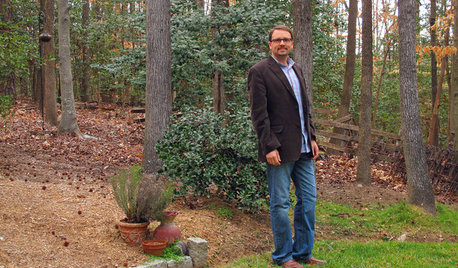My meeting with Duane!
I met with Duane today!!
First of all, what a fantastic guy. He's just a great, down to Earth, laid back, very knowledgeable guy. Meeting with him was a lot of fun and very rewarding.
We walked around my backyard (jungle), and he identified that I have:
- Weeping cherry tree
- Japanese maple tree
- Tea olive tree
- Magnolias
- Pecan tree (YES!!!)
- Butterfly bushes
- Azaleas
- Spiria (sp?)
- Eleagnus (sp?)
- Hydrengas
- Crape Myrtles
- Clematis
- Honeysuckle
- Wisteria
- Flowering quince
- Forythias
- Camelia
- Mandina
- Rhododendrens
- Dogwoods
- Viburnum
- Monkey grass
- Landina
- Hibiscus (Rose of sharon?)
- Holly tree
- Leather leaf Mahonia
With each tree/vine/plant he identified he gave a me a quick lesson on the plant. For instance, he pointed out blooms that are just now starting to appear on the plant, described what they'd look like, gave a bit of info on their growth habits, how this or that plant was good for nitrogen, how this or that plant attracts beneficial insects, butterflies, bees, etc. Our walk was very educational. I had no idea about the diversity I have in my yard.
*begin laughing here*
He suggested that one of the things I should consider really soon was to start using worms.
I don't know what he called it exactly, but using worms for...um...composting...? I think. Whatever the particulars, I'm sure I'll give it a try.
*end laughing*
He suggested that the front yard would be best suited for the food garden; gave me some quick advice on using rain barrels and composting; that he'd be sending me links on worms, composting and other things of interest based on my yard and what I want to do.
Duane pointed out all of the interesting places that are excellent habitats for all sorts of critters and bugs, and suggested that I leave those untouched.
What'll happen now is that - now that he's had a chance to see the property up close, he'll make a plan for putting a garden in the front yard. The back will stay largely untouched for a while. He's going to put a plan together to get the food garden in the front started. He'll follow up with me in a week or two.
I have rabbits!!!!! I know that they may be problematic, but in the interest of creating an eco garden / critter friendly habitat, it's all good. To me anyway. And the rabbits I'm sure. We didn't actually *see* any rabbits. We just saw their... signature, if you will. Since the food garden will be in the front, and the rabbits are in back, I'm hoping the front yard (fenced from the back yard) will be spared from the rabbits.
To surmise, I had a really great meeting with Duane. It was interesting to see him walk the yard and just start giving all this info on each plant we passed. Without hesitation. On top of all that, he politely endured my overt enthusiasm, and was very ok with the fact that I know very little about gardening.
I can't wait to see what kind of plan he comes up with! I will absolutely be taking a lot of "before", and a whole lot of "during" photos that I'll post on my (still unpublished) web site.
I'd enjoy hearing y'alls thoughts about my yard, worms, rabbits - whatever!
KJ








bagsmom
Iris GW
Related Professionals
Ballwin Landscape Architects & Landscape Designers · Saint Louis Park Landscape Architects & Landscape Designers · Wheeling Landscape Architects & Landscape Designers · Brownsville Landscape Contractors · Canton Landscape Contractors · North Haven Landscape Contractors · Paso Robles Landscape Contractors · Secaucus Landscape Contractors · Shirley Landscape Contractors · Thonotosassa Landscape Contractors · Olean Fence Contractors · Whittier Fence Contractors · Costa Mesa Window Contractors · Fort Myers Window Contractors · Deltona Window Contractorsgirlgroupgirl
Iris GW
kajaOriginal Author
satellitehead
kajaOriginal Author
bagsmom
Iris GW
Iris GW
bagsmom
girlgroupgirl
Iris GW
kajaOriginal Author
Iris GW
kajaOriginal Author
satellitehead
roswell_organic
kajaOriginal Author
kajaOriginal Author
bagsmom
kajaOriginal Author
liliumskygazer
Iris GW